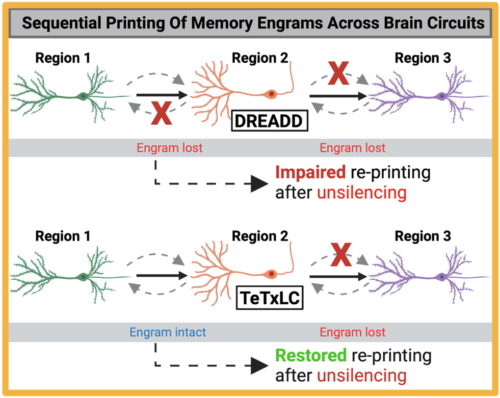Remembering and forgetting by selective changes in brain circuits
Memories make us who we are. From one day to the next, we acquire new memories and build a directory of facts and events and their associations. With this "directory of memories" stored in our brain, we make sense of our surroundings and ourselves, judge, make decisions, and take calculated behavioral actions. Living independently would become extremely challenging without the ability to recall memories of all that we learned and acquired in our lives. As we age, recalling previously formed memories often becomes difficult and removes our ability to correctly make sense by associating facts and events. In various memory dysfunctional and Alzheimer's diseases, when brain circuits become disconnected, and memory is either inaccessible or erased, devastating individuals as they lose the ability to recognize who they and others are.
Brain circuits organize memories for skill sets and action outcome, that allow us to perform tasks. Specific brain circuits are dedicated for pattern separation and completion to distinguish between similarities and differences for judging and decision-making and execution of appropriate action outcome. Even for a simple task, such as food on a plate and a fork in the hand, the brain allows us to properly use the fork to pick up the food and take it to our mouth for feeding. When one forgets something, like a car key, we search for clues to trigger memory recall. Disruption of brain circuits makes execution of simple tasks incredibly difficult.
Brain circuits are composed of different cell types, such as neurons and glia. The human brain has roughly 80 billion neurons, each making up to 1000 connections with other neurons. Each neuron has axons and dendrites. The axons have tiny protrusions called boutons that contain vesicles loaded with neurotransmitters. These are released when neurons are excited to generate an action potential, an information currency of the brain. The released neurotransmitters into the extracellular space bind to receptors and channels on the tiny protrusions called spines located on the dendrites of other neurons. This way, information is transmitted from one neuron to the next.

To investigate the role of the hippocampus’s dentate gyrus (DG), a brain region crucial for various learning and memory processes, we have deployed a simple form of classical conditioning, considered a prototypical model of declarative memory in cognition. Experimentally, we used trace eyeblink conditioning as a model. Animals were presented with an unconditioned stimulus (US) to the eye to elicit an eyeblink, followed by a conditioned stimulus (CS) such as a tone. After several days of conditioning with US and CS, the animal learned to blink when alone was presented.
In a previous study by Prof. Dr. Jose Maria Delgado and colleagues, the previously formed memory was erased when tested after unsilencing it when DG was inactivated. The author concluded that the inactivation of the DG erased the memory of the learned experience. In a recent study, the ACHUCARRO and IKERBASQUE researcher Prof. Dr. Mazahir T. Hasan and Prof. Jose Maria Delgado-Garcia at the Universidad Pablo Olivade Seville and published in the Nature Journal “Molecular Psychiatry,” the researchers selectively blocked the output of the DG. With this selective manipulation, they found that memory retrieval was enabled after unblocking the DG output. The researchers concluded that DG is needed for memory retrieval.
To reconcile the discrepancy between the two studies, the researchers postulated that in the previous study, inactivation of the DG used a genetic technology that hyperpolarized the neurons, which interfered with both anterograde and retrograde synaptic signaling. Therefore, the memory engram from the entorhinal cortex (EC) to DG and DG to the CA3 region of the hippocampus were blocked, which erased EC-DG and DG-CA3 memory engrams. In the current study, the researchers selectively erased the DG-CA3 engram by blocking DG output. After unblocking, the EC-DG engram was reprinted back to re-establish the DG-CA3 engram for memory retrieval.
On the one hand, the technology used in the previous study provides exciting possibilities for eradicating a memory engram of a prior learning experience, with prospects to potentially treat bad memories. On the other hand, in the current study, the technology developed by Prof. Mazahir T. Hasan establishes the crucial role of DG in memory retrieval and provides deeper insight into the proposed mechanisms for sequentially printing memory engrams from one region to the next.
By understanding how circuits operate in forgetting and remembering, novel strategies could be developed to treat various memory dysfunctions, such as those related to aging, posttraumatic stress disorder, and Alzheimer’s disease.
Check the article here:
- Carretero-Guillén A, Treviño M, Gómez-Climent MÁ, Dogbevia GK, Bertocchi I, Sprengel R, Larkum ME, Vlachos A, Gruart A, Delgado-García JM, Hasan MT. “Dentate gyrus is needed for memory retrieval.” Mol Psychiatry. 2024 Apr 12
- https://doi.org/10.1038/s41380-024-02546-0
